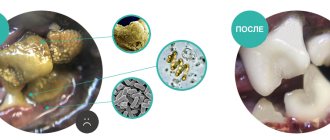The dog arches its back and trembles
If the dog raises its back, trying to lighten the load on its hind limbs, it may experience pain in the lower back, pelvic joints, and this may also indicate a hernia, rheumatism or disease of the urinary system, or pathology of the genital organs.
The pet changes its gait, bows its head, slows down, and stiffness appears in its movements. An unnatural curve of the spine and a hard, hot belly indicate stomach cramps or volvulus. For a successful outcome, it is important to seek help in a timely manner; any self-medication is excluded. Correct diagnosis will help to establish and eliminate the cause of the disease. Blood tests, ultrasound of the peritoneal area, X-ray or MRI and CT examination will be required. The procedures are carried out in veterinary clinics; proper treatment is carried out only under the supervision of a veterinarian.
Take the Attention Test! Find 10 differences! (click right here!)
Find the answer Are you bothered by some problem or question? Enter “Breed” or “Name of the problem” into the form, press Enter and you will find out everything about the issue that interests you.
Trembling in animals occurs due to various reasons. Provoking factors can be harmless or dangerous to health. The degree of danger is assessed based on the totality of all symptoms that appear.
What symptoms along with trembling should you contact a veterinarian for help?
Trembling (tremor) is a rapid, uncontrolled contraction of the muscles of the limbs or the entire body. The symptom is a consequence of the dog’s painful or emotional state. The cause of trembling may be natural, for example from cold.
Trembling is caused by:
- failure of electrolyte balance in the body;
- intoxication;
- neurological disease;
- allergy;
- hormonal imbalance;
- hypoglycemia;
- infection by parasites or viral infection;
- stress;
- injury;
- a sharp decrease in calcium in puppy dogs;
- overheat.
With an electrolyte imbalance in the body, the ratio of potassium and magnesium levels is disrupted; malnutrition and impaired functioning of the thyroid gland and kidneys can provoke a malfunction. Characteristic symptoms are trembling, low blood pressure, pale mucous membranes, irregular pulse, elevated temperature - the dog tucks its tail and shakes as if frozen, convulsions are possible.
Intoxication is caused by spoiled or unsuitable food for dogs, ingested chemicals, insect bites, and snake bites. Tremors, difficulty breathing, high blood pressure, low or high temperature, copious saliva, and foam from the mouth appear. Diarrhea and vomiting with blood may occur. Coordination is impaired, mucous membranes change color - they turn blue or red.
Epilepsy provokes severe convulsions, the dog sticks out its tongue. Typical symptoms include restlessness, vomiting, difficulty breathing, trembling of the whole body, and fainting. The provocateurs of the disease are head injuries, exposure to an electric discharge, severe intoxication, and a hereditary predisposition to the disease is possible.
Trembling may occur together with typical allergic symptoms (inflammation of the skin, itching, discharge from the eyes, ears, nostrils, frequent bowel movements, etc.).
A lack of thyroid hormones (hypothyroidism) is manifested by trembling, weakness, rapid heart rate, rapid weight gain, skin diseases, excessive shedding, diarrhea or constipation.
Hypoglycemia causes diabetes; a decrease in glucose levels provokes trembling, weakness, loss of appetite, excessive salivation; in severe cases, convulsions, fainting, and paralysis are possible.
Trembling, along with other symptoms, is caused by infectious and viral diseases. The painful condition is often manifested by fever, stool disturbances, vomiting, and cough. Bladder infections and kidney disease cause frequent (sometimes unsuccessful) urges to go to the toilet, incontinence, and discoloration of urine. When infected with worms, frequent trembling appears, body weight decreases, digestion is disrupted, the stomach increases in volume, and the animal’s mouth smells unpleasant.
Trembling is characteristic of a nervous disorder, when experiencing stress, the dog begins to tremble, this is possible when the usual environment changes, the dog may be restless or apathetic, begins to whine, howl, refuse to eat or demonstrate an unhealthy appetite.
Trauma can lead to neurological pathologies, shock accompanied by trembling, increased breathing, cold extremities, and pale gums are possible.
Trembling in pregnant or whelping bitches is caused by eclampsia - a significant decrease in calcium, leading to a malfunction of nerve cells. The appearance of vomiting, high fever, and breathing problems indicate the need for urgent contact with a veterinarian. Until the mother's health is restored, the puppies are transferred to artificial feeding.
Overheating in dogs occurs in the summer; prolonged exposure to the sun risks heatstroke. A similar effect is possible in dogs left for a long time in closed cars when it is hot outside. In addition to trembling, dogs experience breathing problems and weakness.
Associated symptoms indicating a painful condition:
- high or low body temperature;
- diarrhea;
- vomit;
- changed color of urine;
- allergic reactions;
- change in color of mucous membranes;
- breathing problems;
- change in behavior (aggression, apathy);
- weakness, drowsiness, poor appetite, thirst;
- lack of coordination;
- loss of consciousness.
Any of the listed signs obliges the owner to pay close attention to the health of the pet and promptly contact a veterinarian.
What procedures does the veterinarian prescribe?
Appropriate treatment is prescribed by a veterinarian after the cause of the trembling is determined; sometimes it is necessary to undergo an examination and obtain test results.
In case of electrolyte imbalance, intravenous administration of a water-salt solution is required. To avoid further problems, you need to examine the thyroid gland, kidneys, and carry out proper treatment of the identified diseases.
In case of food poisoning, first aid can be provided to your pet at home; the dog is induced to vomit, given an absorbent, and provided with plenty of fluids. If the cause of intoxication is not clear, the dog should be shown to a veterinarian. Gastric lavage, intravenous drips, and the use of antispasmodics, antiemetics, homeopathic and cardiac medications may be required.
For animals suffering from epileptic seizures, the veterinarian prescribes antiepileptic drugs and anticonvulsants.
To eliminate allergy symptoms, antihistamines are prescribed; in some cases, antibiotics and the use of hormonal and antifungal drugs are required.
https://dog-care.ru/zdorove/voprosy/sobaka-vygibaet-spinu-i-drozhit.html
In case of hypothyroidism, the deficiency of hormones is compensated for with hormonal drugs, the dosage of which is calculated only by a doctor.
In case of hypoglycemia, glucose injections are given; advanced disease requires thorough treatment; failure to provide timely assistance threatens hypoglycemic coma and death of the animal.
Depending on the virus or infection, different drugs are prescribed; these can be antibiotics and vitamins, mucolytic cough suppressants, immunostimulants, antiviral injections and other medications. In the fight against worms, deworming tablets or suspensions are used.
Dogs are prescribed sedatives to eliminate anxiety caused by changes in residence, exhibitions and other situations.
Depending on the severity of the injury, different treatment methods are used; painkillers can be used for pain syndromes.
If calcium levels are insufficient in pregnant or pregnant dogs, calcium chloride injections or calcium gluconate supplements are prescribed.
For all diseases, only a veterinarian can provide proper treatment.
Why does abdominal pain occur?
There are a number of known diseases that can cause abdominal pain. This can be mild food poisoning or a serious disease of the digestive system.
If an animal feels hungry, it can quickly swallow small objects, which leads to the development of severe pain in the stomach.
The following diseases are considered common causes:
- Intestinal parasitic diseases - helminthiasis or giardiasis.
- Intestinal obstruction, bloating and flatulence.
- Eating disorders.
- Infectious diseases and poisoning with poor quality food or toxic substances.
To determine the exact cause, the dog will be thoroughly examined by a veterinarian. A reliable diagnosis allows you to quickly and effectively treat your dog, relieve your pet of pain and restore health.
Why does a dog tremble after vaccination?
Any vaccinations have side effects. The post-vaccination reaction is expressed by the dog's slight trembling, refusal to eat, general weakness, diarrhea or vomiting, elevated body temperature, and the appearance of painful swelling at the injection site. The occurrence and intensity of the consequences after vaccination depend on the characteristics of the animal’s body.
To avoid or minimize the side effects of vaccination, the dog needs to be prepared for the procedure - choose a qualified veterinary clinic, deworm it 1-2 weeks before the visit, and also make sure that the pet is not suffering from any disease symptoms.
Usually, all complications after vaccinations go away on their own without intervention. Alarming signs that require the services of a veterinarian include severe convulsions, allergic reactions, prolonged refusal to eat, diarrhea or vomiting for more than 3 days, body temperature exceeding 39°C, and other symptoms that do not go away or worsen.
After the vaccine, quarantine is required, during which the pet cannot be taken outside, bathed, and contact with other animals is prohibited.
It is important to monitor your pet’s condition after vaccinations and be prepared for possible complications.
How does Perthes disease manifest?
Symptoms of Perthes disease can be specific - depending on the stage, and general - present in any case. Common signs include rapid fatigue of the animal, decreased mobility of the hip joint, and lameness of varying severity. A dog diagnosed with Legg-Calvé-Perthes disease is unable to move the affected limb to the side.
Many owners suspect a problem when the dog, after running a few meters, stops and begins to tuck its back paw. This occurs due to increased pain. As long as the dog remains calm and does not move, the pain may go away. However, the animal's condition is gradually deteriorating.
At the height of Legg-Calvé-Perthes disease, the pain syndrome is so severe that the dog's behavior can change to the point of aggressiveness. This is especially evident in cases where the owner touches the injured limb (for example, while washing the paws). Gradually, the dog refuses to move, and keeps its paw raised so as not to lean on it.
Trembling you can ignore
Often trembling in animals occurs for natural, non-critical reasons.
Harmless factors that cause trembling include:
- cold;
- sexual rut;
- emotional sensitivity;
- fear;
- dream;
- age.
Freezing, the dog tucks its tail, begins to tremble, and breathes intermittently. An animal can freeze not only during a walk, but also at home, after water treatments.
Sexual activity promotes unusual behavior. Seeing individuals of the opposite sex, dogs begin to shake, whine, become overexcited, attract attention in every possible way, and try to run away. Only spayed or neutered males and females are not susceptible to this. Trembling caused by a hormonal surge during the period of attraction to a partner is safe for the pet; the condition is normalized when hormones naturally stabilize.
Dogs often shake from an excess of feelings - excitement, joy. The dog usually demonstrates this behavior when the owner returns or when visiting familiar guests. In older dogs, excess emotions can cause jaw trembling.
Trembling and rapid breathing are possible with fear; the dog may be afraid of a large animal, a crowded place, a sharp sound - a clap of thunder, a volley of fireworks, sirens of special equipment, etc.
Sometimes tremors appear during sleep, but the tremor disappears while awake.
Old dogs develop tremors in their limbs. Senile trembling of the hind and apron legs has little effect on the movement of dogs and does not require treatment in the absence of other disturbing symptoms.
How to eliminate chills in your dog yourself
Sometimes it is difficult to determine the cause of chills in a dog; you need to try to analyze the pet’s well-being, remember the events of the past days that could have affected the pet’s condition. A high temperature indicates possible infectious diseases or diseases of the internal organs.
If hypothermia is suspected, the dog should be warmed with a blanket or heating pad. To prevent the dog from freezing during walks in winter, he needs to wear special clothes. After home water treatments, the dog's fur should be thoroughly dried using a towel or hair dryer.
First aid for a hypoglycemic attack in an animal is to raise the glucose level, for this you can use honey (if there is no allergy), lubricate the gums with it or place it under the tongue every 6 hours until the trembling subsides or until veterinary intervention.
In case of poisoning, the dog requires gastric lavage, taking an absorbent, and drinking plenty of fluids. Allergy symptoms are suppressed with antihistamines. A frightened dog can be calmed down by a walk, a calm voice, the creation of familiar conditions, and eliminating the cause of anxiety.
Complex cases require a mandatory examination of the pet by a veterinarian. Only timely correct treatment will lead to a favorable outcome.
What dogs don't like
1. Using words more than body language
© Sergey Nivens
Man is a creature capable of speaking and conducting dialogues.
We especially love to talk to our pets, who cannot understand the vast majority of what we say.
Over the course of their lives, dogs can learn the meaning of some key words that their owner regularly repeats to them: “You can’t! Walk! Let's go! Bring me a toy!”
Some dog breeds can recognize up to hundreds of different words and commands. But even if your dog knows selected phrases, this does not mean that he understands human language.
What animals rely on is our body language. Only through sign language can they understand what we mean and what we require from them.
Dogs are true experts and can read through human body gestures what you are thinking and feeling before you even realize it.
However, if we only pay attention to what our mouths say and not what our gestures dictate, we may be sending mixed, erroneous signals to the animal.
© HD92
It is worth visiting any dog training school and you will notice how some people say one thing and do another, confusing the dog in the process.
For example, when giving a dog the “sit” command, trainers lean forward and extend their hand. In body language, this means inviting the dog into your personal space.
But when the dog follows this gesture while being verbally commanded to sit, he is reprimanded for the violation.
If you are interested in testing your pet, conduct a small experiment (your dog will only be grateful to you for it).
Try to spend an entire day without saying a word to your dog, but communicating with him only through body gestures.
You will understand how important body language and gestures are in communicating with your dog.
You will be able to communicate with her perfectly without using a single word. A conversation with a pet may well proceed without words using only gestures.
2. Hugging a dog
© Svetozar Milashevich / Pexels
Surely you like to hug your four-legged friend. Wrapping your arms around your pet's furry neck is always great! This is how we fight stress and lift our spirits.
It may surprise you to know that most dogs hate hugs. It seems to us, as higher primates, that hugs are an amazing thing, thanks to which you can express a sea of feelings.
Support, love, joy and other emotions can all be expressed through hugs. It is completely normal for us to hug and squeeze something valuable in our arms.
But dogs are not developed enough to understand all this. They don't have hands and don't hug. And it’s not customary for dogs to show their feelings and signify camaraderie in this way.
Remember this: if a dog puts his front paw on another dog's back, in their language it is considered an act of dominance.
Therefore, regardless of your intentions for hugging and showing friendly intentions, the dog views the act of hugging as a demonstration by the person of his dominance over the animal. After all, in the process of hugging, you put your hand on her back.
Most dogs tolerate hugs patiently, since for them the owner and the person, in principle, means superiority over the animal.
However, some individuals will feel fear and threat from humans.
You can feel this fearfulness and trembling. Some dogs may snap and even bite. After all, it seems to them that you are encroaching on their freedom.
© Robert Kneschke
Additionally, the same dog that accepts a hug from one person may react completely differently to another family member who tries to do the same. After all, if she accepts the hug of the first one, it simply means that she sees him as a leader and master.
You'll be hard-pressed to find a dog that truly loves cuddles and cuddles.
Want to check that this is really true? Just pay attention to her behavior when you hug her.
Is she tense? Moves his head away? Avoids even a hint of eye contact? Licks his mouth with his tongue? Or does he keep his mouth shut? Or maybe she presses her ears back to her head? All these signs indicate that the dog is currently experiencing discomfort. She's uncomfortable.
When a dog licks a person hugging him, it does not mean that he is showing his obsession with love for him. This is how she shows submissiveness and nervous behavior.
So the next time you want to hug your dog, pay close attention to all these signs that he is uncomfortable.
Which breeds are most likely to naturally tremble?
Individuals characterized by increased nervous excitability, manifested by natural trembling, include the Chihuahua, Yorkshire Terrier, Toy Terrier, Pomeranian Spitz, Dachshund, and Lavretka. Small dogs do not cope well with emotional stress; this provokes muscle tension, expressed by trembling of the limbs, head, and tail. The dog begins to shake in anticipation of a treat, at the sight of the owner or familiar guests, when going outside. The physiological tremor characteristic of these breeds does not threaten the health of the pet.
Representatives of small breeds are more susceptible to hypothermia, they react to cold with trembling, blood flow accelerates, and muscle contraction prevents thorough freezing. Such dogs need to wear special dog overalls during the cold season. Chihuahuas get cold even indoors; these dogs require plenty of warm clothing accessories.
What is Perthes disease?
Legg-Calvé-Perthes disease is a disease of the animal's femur and hip joint. It is associated with impaired blood supply to the head of the femur, as well as impaired nutrition of the cartilage of the hip joint. The disease is accompanied by the formation of deforming arthrosis.
Small dog breeds at risk include:
- toy terriers,
- Pekingese,
- schnauzers,
- pugs,
- poodles,
- Spitz,
- Jack Russell Terriers, etc.
Often Perthes disease occurs in puppies that have reached 6-7 months, but clinically it begins to manifest itself a little later - after 8-11 months.











